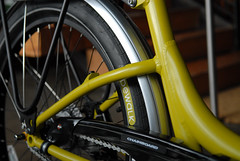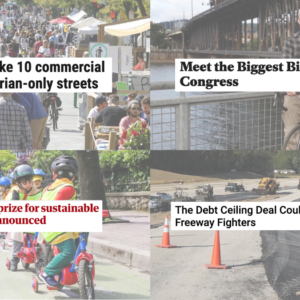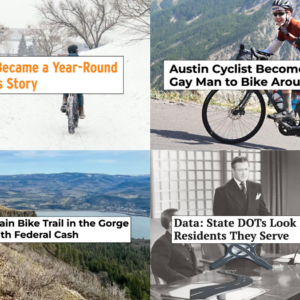[Note: I’m going to try and start doing more product reviews. I’ll post quick “On Test” updates as I get interesting things to try out. Then, depending on your interest and the quality/relevance of the product itself, I’ll follow-up with a more thorough review. To keep this going, I’m looking for a product review intern. Get in touch if you’re interested.]
The Urbana, which debuted at the Interbike trade show last fall, is an interesting bike. With its design roots in downhill mountain biking, it aims to be a fun, versatile, one-size-fits-all urban commuter.
The bike’s creator, Jerome Roy of Balfa Bikes fame, puts it this way, “The Urbana was conceived the same way [as his full-suspension mtbs]; utilitarian and always ready for fun, it can go through potholes or jump over them!”
A rep from the company, Haniya Hussain, recently took a swing through the Pacific Northwest and gave me an Urbana to check out. The things I noticed first were; the pothole-eating, 2.6-inch tires, beefy, step-through frame, BMX-style handlebars, and sturdy rear rack. It’s definitely ready for urban assault.
The bike, which retails for around $1,200 (depending on drivetrain), was designed to fit a range of sizes from 5 to 6 1/2 feet tall. “That way,” Haniya says, “If you have two people living in an apartment, you only need one bike between then.” (I like the versatile size idea for fitting a variety of house guests). It’s also built with interchangeable dropouts to accept a range of gearing options (most common being 3 or 8-speed internals). (Full specs here)
The primary goal of the Urbana is fun. “We noticed there were many a-to-b bikes, but none of them were actually fun.” In addition to making a bike that is fun to ride, Urbana is trying to build community. On their website, you can register your bike and then check a Google map to see if anyone else in your neighborhood has one. Another nifty feature is the unique, laser-cut serial number on each frame. If the bike is stolen, Urbana wants to hear from you. They’ll send out an email to all their dealers to look out for it.
My initial impressions: Given its comfortable angles, upright riding position and big tires, it seems like a great bike for people just starting out (rental companies should be all over this thing), or for someone who needs a sturdy grocery-getter/neighborhood errand runner. It’s also perfect for keeping around as an extra bike that will work for anyone. It’s a bit too relaxed and slow for my tastes, but the big tires are awesome. I have been tearing up my yard and riding over all sorts of stuff without issue.
Because the sizing of this bike is so versatile, I’m considering it for an idea I’ve been stewing on for a while now — a community test ride. I’m thinking about hanging out on a busy bikeway and letting folks stop to give it a spin.
Given what you’ve seen and heard, what do you think? Is this the kind of bike that can get people excited to ride? Will it do well in Portland (Haniya says at least one local shop is very interested in it)?











Thanks for reading.
BikePortland has served this community with independent community journalism since 2005. We rely on subscriptions from readers like you to survive. Your financial support is vital in keeping this valuable resource alive and well.
Please subscribe today to strengthen and expand our work.
It looks good to me, but what do I know. I like to see your reviews and consider them usefull
And this thing weighs how much? I’m the first person to make fun of weight weenies but why are people assuming that weight doesn’t matter at all in urban bikes? You have lots of brake-accelerate cycles due to stop signs/traffic lights and you want to be able to carry the bike up and down stairs (to your apartment, to the subway, …)
anonymous,
weight was a concern of mine too. it’s not light but I don’t recall exact weight. I am on the fence about weight and racey-ness of commuter bikes. While I personally like something that can go fast when I need it to, I also want to recognize that people ride waaaay too fast on bikeways (and rudely too), so maybe it’d be good for more bikes to encourage slower speeds? I don’t think this bike will appeal to people with 5 mile (one-way) commutes. I think it’s sweet-spot is neighborhood jaunts or for people that live in dense, urban areas and have a small transportation circle.
Why do you only need 1/2 bike per person? I have 5/3 bikes per person in my house and I’m considering upgrading. 2 reasonable bikes retail for less than this 1 bike
Yow, $1,200 for a neighborhood jaunt is a hard pill to swallow!
However, I would certainly like to see more reviews on this site, and will read them whether or not they have anything to do with bikes I may want to ride.
More information about your test models would be good though, such as weight of model tested, what all is included with it, etc.
and expensive.
I have a growing uneasy feeling that the “commuter bike” genre is a marketing ploy aimed at the uninformed, designed to sell bikes based on their cuteness, pretty colors, and unthreatening style. The Urbana seems to be made of aluminum. On my commute from Aloha to Gresham I’ve settled on either a steel touring bike or a Brompton if I use MAX part of the way. Part of why these work effectively as commuter bikes is that they’re made of steel. Steel is important in a commuter bike because only steel effectively triggers traffic light signals. Maybe most of the lights in downtown Portland are timed, but in the ‘burbs if you can’t trigger lights you’re transformed into a pedestrian at each intersection or you are at the mercy of cars going your way to trigger lights for you. So to conclude, I wonder if the designers of aluminum commuter bikes have ever really tried commuting on them the way most customers of these bikes would use them.
@#7
My aluminum track bike will trigger light signals. I do it daily as I enter Ladd’s addition from Seven Corners.
To second that, even my full carbon frame bike triggers signals. I don’t think this is a concern (at all). It only matters at rush hour anyhow… since most of the time almost no one is on the road and waiting is for those who respect rule of law.
I generally have no problems tripping lights w/ my aluminum bike… You just need to learn where to sit while you’re waiting, this is true for most bikes and sometimes even motorcycles.
In-road traffic signal sensors are typically inductive loops. These need something magnetic (like iron) to pass over them to trigger a light change. It’s the same reason ferrous-based cookware is needed for induction stovetops. If your non-ferrous bike triggers the light it’s because of the steel in the other components. Some sensors are more sensitive than others, and I’ve had some luck with an aluminum bike triggering some, but a steel frame bike has a much higher chance of triggering a light than a non-steel bike. I commute with a person who rides both aluminum and carbon bikes so I’ve had an opportunity to informally test light triggerng with different frame materials. Steel wins hands down.
I can see it being better, but not required for triggering lights. At least not enough to to change what kind of bike to buy (in my opinion)
@Peter Buck (#11), Inductive sensors only need something conductive, not something ferrous, enlightened DOTs use a single bike wheel (single wall aluminum usually) to check the calibration of the sensor. You do have to stop your bike directly over the wire in the loop to trigger a sensor, being just a couple of inches off to the side will make the bike invisible to the sensor.
I agree with anonymous (#2): So many of these urban bikes are way too heavy. I see people struggling to ride them up the rise on the Hawthorne Bridge. I’m afraid that may beginner riders will be lured into a soft, heavy bike only to quit cycling because they’re so much work! That said, to each his/her/their own.
Well, I stand humbly corrected. Aluminum wheels apparently do make excellent conductive loops. I found two interesting articles on this subject at linkhttp://www.humantransport.org/bicycledriving/library/signals/detection.htm and http://www.humantransport.org/bicycledriving/library/signals/green.htm. I apologize in advance if my html tags don’t work in the links.
Jonathan,
your point about bike speed and rudeness is odd. I don’t live in Portland and thus have no opinion about the topic in general, but a technological fix in the form of overly heavy bikes does not make sense on different levels. From a physics standpoint it just doesn’t work: Bike weight matters only on uphills and when accelerating. If you’re going on a level road and are past the acceleration stage you can ride a heavy bike just as fast as a lighter one. And on downhills you can even go faster. I’m assuming that you’re probably not concerned about people going too fast on uphills or accelerating too fast after a traffic light.
In addition to this aspect, even if it did work the way you imagine it, you’re still ignoring the side effects of bike weight that I’ve mentioned. When I used to live in Berlin, I had a guest bike that probably weighed as much as the Urbana. All of the people riding it had serious issues carrying it up or down the stairs to/from subway stations and even for me it was annoying. If you want a technical fix for high bike speeds, maybe we should mandate a gear limit of 1:1.5 or only sell bikes with overtightened bearings and ungreased chains…
On a different note: if you’ll do more reviews, could you please make clear if the companies give you any compensation/freebies in exchange for the review? It helps your readers assessing the facts presented in the review. (This is in no way implying that your reviews are biased in any way; but I think it’s good practice to have a “conflicts-of-interest” statement, as they call it in the medical sciences.)